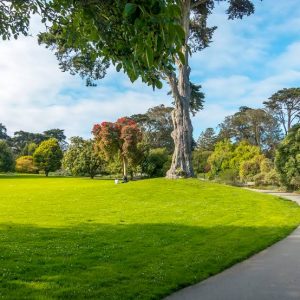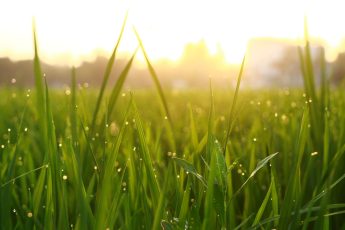It is a fact that shade is an important factor to consider while setting up a lawn in your home. Up to 70% of most grasses found on Earth require direct sunlight to flourish, without which they might whither.
Many leaves of grass tend to emaciate, lose their freshness and color, and the moment enough sunlight is no longer received. It occurs within about 5 hours. Some grasses used to the sun do not survive long with it. A little shading of the light for a few hours could hinder the grass’s growth on your lawn. The roots and shoots are not an exception.
What are shade-tolerant grasses?
Asides from that, a few others flourish and grow very well when not in contact with the sun. These are the shade-tolerant grasses. With about 3 to 5 hours of direct or indirect exposure to the sun, they tend to flourish.
A shade is further classified into the full shade- received for a larger part of the day, and partial.
How to Grow Your Grass?
A little more light penetrating the lawn could be all the grass needs to increase in size, length, and overall growing condition.
- Constantly competing for sunlight can have special effects on the grass, and you should avoid it.
- Increase the level of sunlight accessibility into the lawn.
- You can discover the level of growth experienced by even the shade-tolerant grasses when exposed to sunlight.
- Start by trimming the grasses and creating enough space for air and sunlight to penetrate.
- When the lawn grasses are constantly trampled upon, they become weak, and if care is not taken, they might whither.
- Reducing the level of entrance into the lawn helps to prolong the lifespan of the grass plane.
Also, ensure that your lawn’s irrigation pattern is suitable for the type of grasses found on it. Grasses with slow growth do not require much water.
Certain types of grasses can contribute to their poor growth. It happens when they strive for the limited nutrients and resources found on the lawn.
Learn more about gardening, HERE.
Setting up Your Lawn
If you live in an environment that gets a minimum amount of sunlight each day, then setting up a lawn may be hard to achieve. A grass plant seeds like the Pennington smart seed sun and shade are examples of grass seeds with a high tolerance for shade.
Things to Consider When Setting up Your Lawn
- Before setting up your lawn, access the weather conditions in your area. It could be that the sunlight is extreme during a particular season.
- Getting used to when the sun goes down can help in knowing the right grass to add to your lawn.
- Just as the dry and rainy seasons are interchangeable, the season your environment experiences determine the nature of grasses to a large extent.
A warm-season grass tends to flourish when planted in the West or south part of the country. Meanwhile, the cool-season plants are generally found in northern zones, including broccoli, potatoes, and lettuce.
Best Grass Seeds for Shade
Fescues
A fescues grass normally found in the northern regions is the best shade-tolerant grass. Check out the best artificial grasses for your lawns.
This type of grass is invariably the best cool-season grass. From a large grass family known as Poaceae, it is found in both the atmosphere’s temperate and cold regions.
Some of the fescues grass is used as pasture plants, and a few others serve the purpose of erosion control as they can be found on bare grounds.
The fescues have a high shade tolerance that is next to none. The most shade-tolerant species is the creeping red species, seconded by the tall fescue. See the best grass seed for shade.
Ryegrass
The ryegrass from the family of Poaceae has a large number of species ranging from about 10. The ryegrass, planted in various countries like Africa, is used as foliage and as lawn grasses. These include
- the annual ryegrasses
- perennial ryegrasses
The perennial ryegrass cannot flourish in shady conditions. They are mostly found in areas of partial sunlight. The ryegrass grass is very shade-tolerant.
Bluegrass
The bluegrass comprises lender leaf blades, and they could either be annuals or perennials. It ranks the largest in the grass family with over 500 species and is among the family of Poaceae.
Most species of bluegrass are found to serve the purpose of adding beauty to the environment. The bluegrass is abundant in tropical and temperate regions and can best be used as pasture or forage.
Centipede grass
The centipede grass is one of the top warm-season grasses for shade. It is best suited to grow in an environment with a full sunlight supply.
Although it can equally survive in areas of minimum supply of sunlight, the level and nature of its growth in the sun are high. It is unlike the other warm-season grasses that are shade-tolerant.
Native to Southeastern Asia and China, centipede grass is associated with the warm seasons and can be found in southeast lawns.
With a shallow root system, the centipede grass requires constant irrigation during periods of water shortage. However, it is highly sensitive to alkaline soil and shows a high productivity level in warm seasons.
St Augustine grass
The St Augustine grasses, which are otherwise called the Charleston grass, are of high shade tolerance. It is in contrast to other varieties.
The varieties include; bitter blue, sapphire, and palmetto. These varieties of the St Augustine grass are top on the list when it comes to shade tolerance.
When exposed to about seven hours under the sun, they can also flourish, and flora tam, the most common variety of St Augustine, is not an exception.
Zoysiagrass
Zoysiagrass, of the family of Poaceae, is natural to New Zealand and Southeast Asia. It has various perennial species, which are about 5 in number and may cover crops for open or bare areas.
Zoysiagrass is commonly found on coastal grasslands and requires a minimum of six hours to survive under the sun.
Conclusion
You can make your choice when it comes to grass shades, depending on the nature of your lawn and the condition it permits. At times, shade-tolerant grasses may require pruning to enable air and sunlight to penetrate the lawn.
It improves the nature of the grasses and allows for more growth. Also, a good knowledge of the season suitable for your grass shades is necessary as this enables you to decide where you can plant them.
Feel free to comment below. Check out our website for more content like this.



